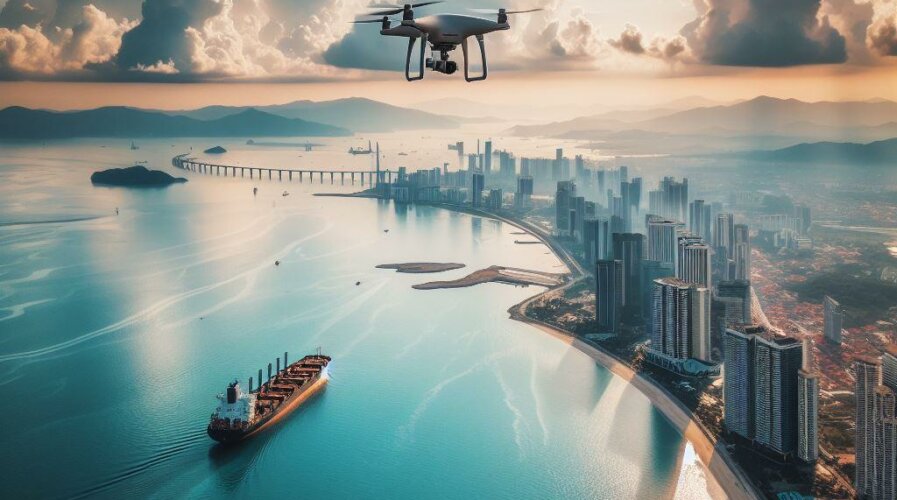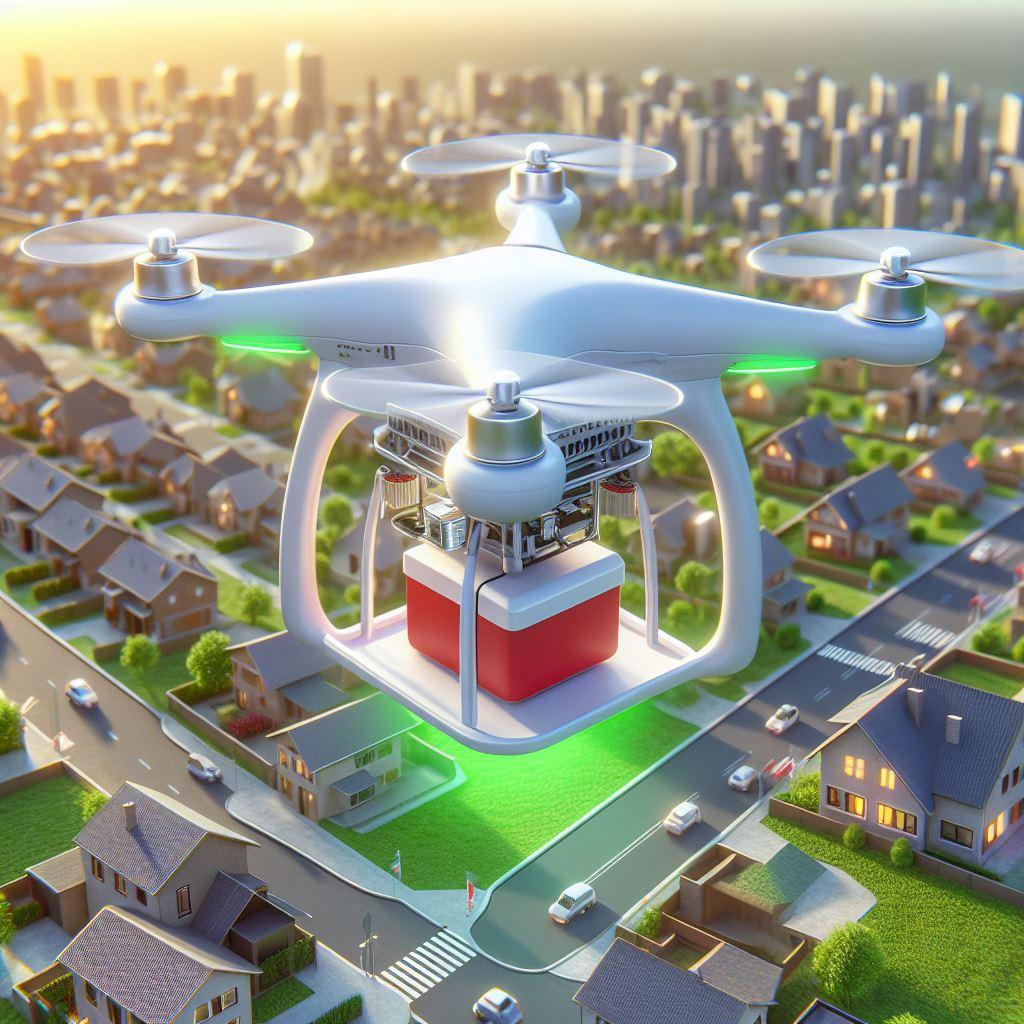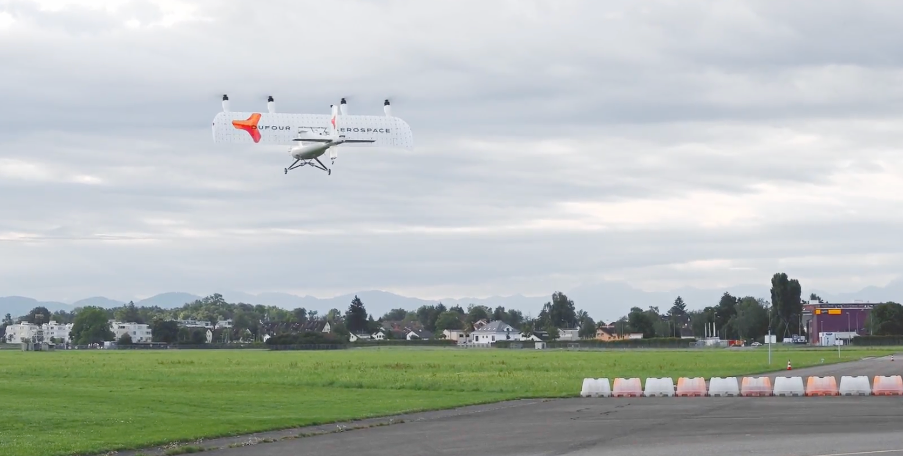
A drone flying between Malaysia and Singapore. (Image generated by AI).
Can cross-border drone deliveries between Malaysia and Singapore work?
- Aerodyne Group and DroneDash Technologies introduce cross-border drone deliveries.
- The partnership enables cargo delivery across national boundaries at any moment, five times faster than sea freight.
- While there are more plans to develop a drone delivery ecosystem, there are also still several challenges and limitations faced.
Drone deliveries were meant to revolutionize logistics when they first made their debut. But despite being around for almost a decade, the drone delivery ecosystem is still not living up to expectations.
Over the past decade, there have been many use cases for drone deliveries developed. In the US, several companies have been using drones for deliveries. Last year, Amazon announced that its newest Prime Air drones will deliver to customers in cities in the UK and Italy, as well as three US locations by the end of 2024. In India, there have been plans for drone deliveries in rural areas to supply medication and essentials.
While there remain plans to develop a drone delivery ecosystem, there are still several challenges and limitations to be overcome. These include:
- Regulations: Drone delivery must comply with various rules and regulations regarding airspace, safety, privacy, and noise. Different countries and regions may have different standards and requirements, which can affect the feasibility and scalability of drone delivery operations.
- Infrastructure: Drone delivery requires adequate infrastructure to support the launch, landing, charging, and maintenance of drones. This may include dedicated drone ports, docking stations, or landing pads, which can be costly and complex to install and operate. Additionally, drone delivery must deal with the “last-meter” challenge of getting the package from the drone to the customer’s doorstep, which may require different methods depending on the environment and customer preference.
- Security: Drone delivery must ensure the security of the packages and the drones themselves. Packages must be protected from theft, damage, or tampering during transit and delivery. Drones must be protected from hacking, interference, and physical attacks that could compromise their functionality or safety.
- Weather: Drone delivery is susceptible to weather conditions, such as wind, rain, snow, fog, or extreme temperatures. These can affect the performance, reliability, and safety of drones, as well as the quality of the packages. Drone delivery may need to adjust or cancel operations depending on the weather forecast and real-time conditions.
- Customer acceptance: Drone delivery must overcome the potential barriers to customer acceptance and satisfaction. Customers may have concerns or preferences about the cost, speed, convenience, privacy, and environmental impact of drone delivery. Customers may also have different expectations and experiences depending on the type of goods they order, such as food, medicine, or clothing. Drone delivery must address these issues and provide a positive and consistent customer experience.
These are some of the biggest challenges that drone delivery faces today and in the future. But they’re not insurmountable problems, and many companies and organizations are working to overcome them and improve the technology and service of drone delivery.

While there are plans to develop a drone delivery ecosystem, there are still several challenges and limitations faced. (Image generated by AI).
Drone deliveries in Malaysia and Singapore
The drone delivery ecosystem in Malaysia and Singapore has been around for some time. In fact, both countries have already been experimenting with drone use cases, even before the Covid-19 pandemic.
While the trial sessions were successful, most of the drone projects announced so far have failed to live up to expectations. For example, in Malaysia, there was a huge interest in drones being used for food deliveries, with Cyberjaya being selected as the initial testing area. However, the project never got going, and the idea of using drones for food deliveries in the area eventually faded out.
In Singapore, foodpanda conducted trials on a drone delivery service for food, too. But even that project has since been shelved.
Part of the reason for these ideas not taking off successfully could be the lack of drone ecosystem and infrastructure in place. The costs involved in such operations would also need to be minimal and based on consumer interest.
Drone deliveries may have a totally different use case when it comes to logistics, though. Using drones for the delivery of parcels, rather than food, is a lot more feasible, and makes a lot more sense given the nature of the products being delivered.

Drone delivery services between Malaysia and Singapore use the specialized technologies of both entities.
Cross-border drone delivery
Aerodyne Group, a global leader in drone-based enterprise solutions provider headquartered in Malaysia has inked an agreement with DroneDash Technologies, a leading air mobility company headquartered in Singapore to introduce cross-border drone delivery services. The drone delivery services between Malaysia and Singapore use the specialized technologies of both entities to boost logistics efficiency across the two countries and advance the region’s delivery and supply chain capabilities.
Both Aerodyne and DroneDash will navigate the regulatory framework, securing all necessary permits to pioneer shore-to-shore drone operations along the Malaysia-Singapore corridor. This venture is supported by the latest in unmanned sea and air technologies, heralding a new era of logistical efficiency.
Central to the operation is a cutting-edge navigation system, crafted from satellite communications with expansive dual-city 5G roaming, to ensure drones safely navigate through congested maritime and aerial paths, significantly boosting operational safety and reliability.
The initiative will initially focus on establishing delivery routes to Johor Bahru and Iskandar Malaysia, strategically chosen for their proximity to Singapore. This phase sets the foundation for future expansion throughout Malaysia, with commercial operations anticipated to start in the third quarter of 2024.
The deployment of drones, capable of carrying up to 30 kilograms and achieving speeds of 150 km/h within a four-hour flight span, promises secure and efficient deliveries.

The partnership enables cargo delivery across national boundaries at any moment, five times faster than sea freight. (Source – DroneDash).
“Organizations in the logistics, cargo delivery and freight services sector stand to gain a double-digit percentage improvement in overall productivity and cost. Drone deliveries are also beneficial for the environment with emissions and carbon footprint being reduced by up to 100% and 80% respectively,” said Paul Yam, CEO of DroneDash.
“Drone deliveries are transforming the speed and reach of logistics operations, and they can help reach remote areas where traditional air and sea freight are unable to access. They also add to the creation of a revitalized and vibrant logistic sector through job creation in operating and maintaining the drones.”
“With the formation of the recent Johor-Singapore Special Economic Zone (JS-SEZ), we are proud to play a part in strengthening economic connectivity between the two regions,” said Mudzakkir Hatta, CEO of Aerodyne (Malaysia’s operation).
“We look forward to venturing beyond the state of Johor with increased shipments to other parts of Malaysia, forging a longstanding trade cooperation with the two partnering nations.”
Designed for critical deliveries such as urgent documents, high-value electronics, medical supplies, and perishable foods, this service promises to redefine logistics between Malaysia and Singapore.
With real-time tracking, advanced security protocols including 256-bit encryption, and blockchain technology for logistical oversight, this initiative establishes a new benchmark for secure, efficient cross-border logistics.
READ MORE
- 3 Steps to Successfully Automate Copilot for Microsoft 365 Implementation
- Trustworthy AI – the Promise of Enterprise-Friendly Generative Machine Learning with Dell and NVIDIA
- Strategies for Democratizing GenAI
- The criticality of endpoint management in cybersecurity and operations
- Ethical AI: The renewed importance of safeguarding data and customer privacy in Generative AI applications


